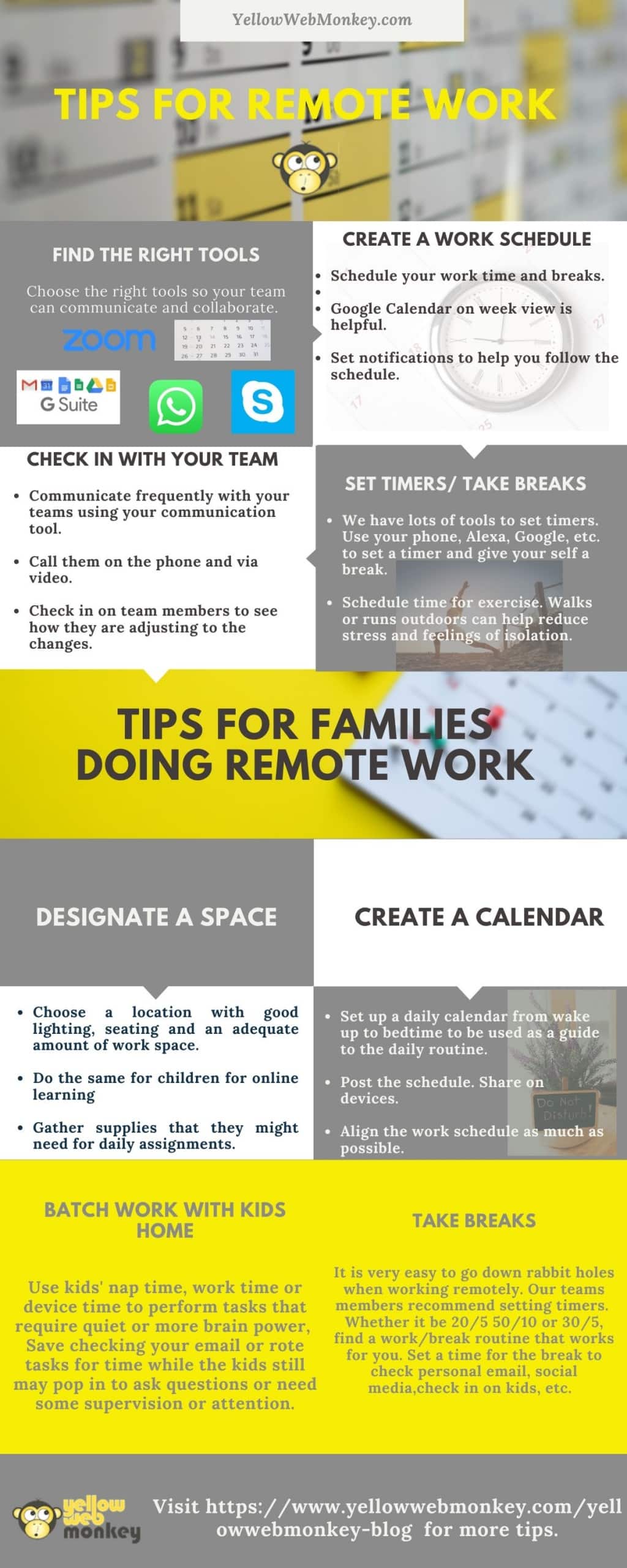As many Americans are transitioning to remote work over the next week, we asked our team at YellowWebMonkey to share their tips and experiences on working remotely and how they stay productive. Many companies and individuals struggle with remote work, but with some tools, tips, and traps to avoid, the typical challenges can be mitigated and productivity can continue.

Our team uses Skype as an easy tool to communicate within our team and we’ve found Zoom to be reliable to communicate with clients and conduct meetings and training. Both have easy screen sharing features to help share information, collaborate and problem-solve. We also use CloudApp frequently to send screenshots and screen recordings to our team members and clients. CloudApp is free and very helpful when creating a knowledge base for team members as it lets you easily copy/paste a screen recording or screenshot and has features that allow easy annotations on an image.
If you’re transitioning to remote work, it’s important to establish some procedures and routines. How will your team check-in each day? When are they expected to be on-line and available? What are
Once the work is structured and your team has the tools to collaborate, take some time to review best practices and determine what your routine at home will be. You may even find that you have more time available without a commute which is one of the top reasons 91% of people polled like remote work. However, distractions can fill that time quickly, so we have some recommendations to limit interruptions and stay productive.
10 Tips for working from home
1. Remove distractions
Turn off the TV, radio, etc. and if you don’t have a separate room or home office available, dedicate a specific space for working.
2. Get Organized
If you have kids home due to school or childcare cancellations, consider hiring a teen to help watch younger kids in your home while you work or help with chores. If you aren’t able to do this for various reasons, it’s important to create a schedule, some ground rules and communicate age-appropriate expectations.
3. Set a schedule
Schedule your work time and breaks. Google Calendar on week view is helpful. Set notifications to help you follow the schedule.
4. Get up and move
Exercise if you are able. Getting outside for a walk or run can reduce the feeling of isolation.
5. Communicate
Communicate frequently with your teams using your communication tools. Call them on the phone and via video. Ask them occasionally about something other than work. Managers should check in on team members to see how they are adjusting to the changes.
6. Adjust your routine
Adjust your work schedule to meet your family needs (if you have the flexibility). When the kids are off school, I get on early before they are up and moving to knock out some initial tasks and then I can take a longer break for breakfast and lunch to spend time with them. I often get back on after they go to bed to finish out any tasks for the day.
7. Check in with clients.
Set up calls with clients to stay connected during this time and check in on ways you can support them or if their needs have changed.
8. Let others know your availability.
Inform those that may stop by unannounced that you’ll be working from home during specific hours and put a do not disturb sign on your door. This can help with children at home too. A sign on the “office” door or entrance can help them understand when it’s ok to interrupt and when it might not be.
9. Batch work.
Use nap time or tv time to perform tasks that require quiet or more brain power, save checking your email or rote tasks for time while the kids still may pop in to ask questions or need some supervision or attention.
10. Turn off the screen!
The distinction between work and home lines can get blurry when working remotely, but it’s important to be able to step away. This is a great time to reengage in a hobby or find a new one.
Be patient and give yourself some grace. Managing work tasks, family tasks and distance learning is going to be an adjustment, but you aren’t alone in going through this challenge. Lean on friends and family when you can for support.
{module YWM WFH Quotes}
Download a .pdf of this infographic by clicking below.









